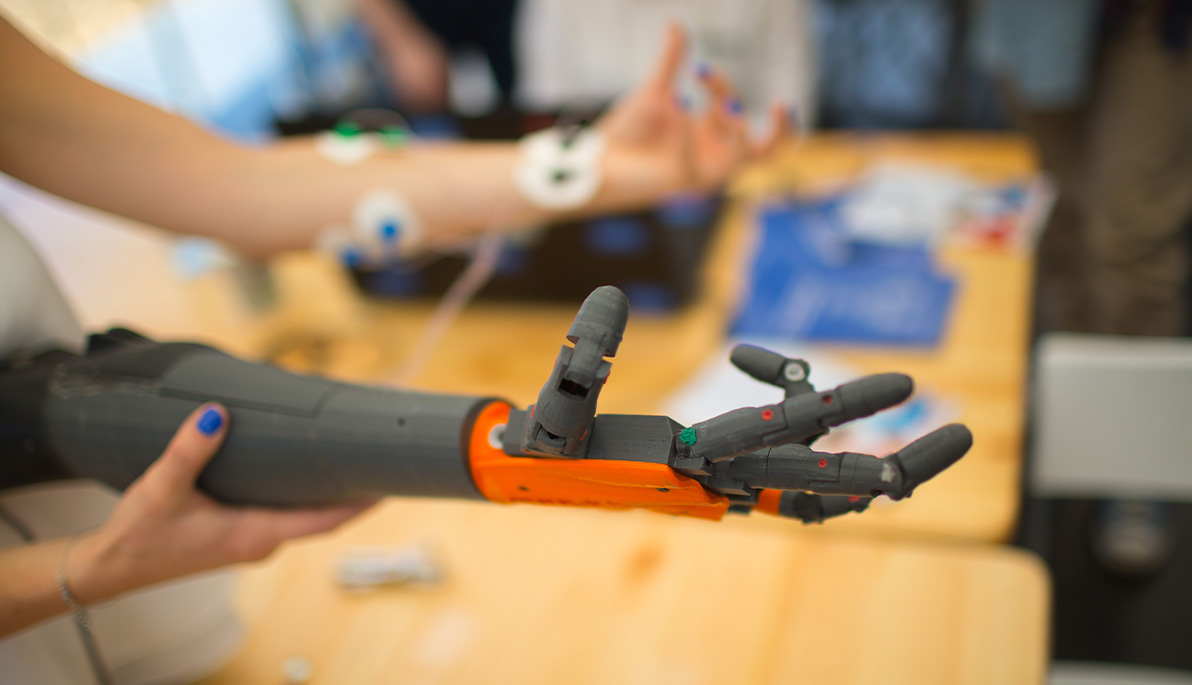News
Getting a Grip on Robotic Hands
June 20, 2022
From cars that park themselves to robots that perform surgery and vacuum cleaners that autonomously scoot across the floor, intelligent machines have become ubiquitous.
Yet, one feat remains a challenge—the ability to create lifelike robotic hands.
Advancements in robotic engineering have brought the world closer to achieving this, including the development of robotic hands that can solve a Rubik’s Cube and others capable of manipulating thousands of objects. However, given the sheer complexity of the human hand, additional research and innovation are needed before robotic hands can autonomously navigate their surroundings and fully interact with objects in the same way that humans do.
To learn more about innovations in this field and what still lies ahead, we sat down with Michael Nizich, Ph.D., director of the Entrepreneurship and Technology Innovation Center (ETIC) and the creator of E.R.R.S.E.L.A., the ETIC Research Robot for Student Engagement and Learning Activities.
What advancements have been made so far, and how have they brought engineers closer to creating more lifelike robotic hands?
Training a robotic hand to perform complex manipulation tasks lays the foundation for more general-purpose robots. So, even though it may still be some time before we see robotic hands in our homes, there is considerable progress being made in the field and the prototypes being produced are taking on more realistic qualities.
For example, researchers at MIT recently developed an AI-driven robotic hand that can manipulate more than 2,000 objects, which could be particularly useful in a manufacturing setting. Another example is Dactyl, a robotic hand created by the research institute OpenAI, which uses neural networks to single-handedly solve a Rubik’s Cube. Some researchers have even developed a kinematic model for a robotic elephant trunk!
Why is it challenging to create robotic hands that mimic human capabilities?
The human hand has many separate bones that work together along with various muscles connecting them at multiple attachment points. This configuration allows for a very specific series of articulation points and movements controlled by a combination of electrical impulses that activate the muscles in very specific and particular mannerisms.
For example, the human hand has 27 bones and 14 of these are digital bones that make up the fingers and thumb. These bones and their movements are controlled by their attached muscles and the electrical impulses that tell them to move. The simple act of picking up a scalpel, for example, would consist of hundreds of bone and muscle combinations and thousands of individual electrical impulses sent in incredibly precise sequences and voltages.
That sounds like no small feat. Does current technology provide additional challenges?
Yes. The limitations of readily available commercial electromechanical controls for engineers in this space provide for a less than realistic imitation of the movements of the human wrist, digits, and the 27 bones of the human hand that make it so unique and incredibly useful.
When engineers try and imitate or emulate the highly evolved configuration of the human hand, we are limited by some of the existing commercial grade systemic controls available to us. For example, we use controls like servos, motors, actuators, and solenoids to simulate digit extensions and may even use springs, rubber, or even plastic to perform the reflexivity response of the digits. These devices are rigid and usually only rotate or revolve around one hinge point. Reflexivity is really a combination of relaxing one muscle and the contraction of another on the other side of the bone.
Additionally, the human hand is controlled by the human brain, which triggers signals to the muscles in the hand to move in precise ways based on thousands of external signals that the brain is receiving from the outside world in the form of visual, audible, and other sensory origins. This is currently incredibly difficult to emulate with the current technology.
If modern engineering can overcome these challenges, what advancements might consumers one day see?
Of course, there are still a lot of unknowns, but I predict that someday we’ll see:
- Many robotic hands entering the prosthetics and manufacturing industries
- One or two leaders emerging based on open-source interfaces for hand adaptation
- The adaptations of these leading robotic hands into standard assistive devices for the elderly, infirmed, and impaired
- Mainstream acceptance of hands-on uses in a variety of industrial devices and industries including machine control, packaging, security, and repetitive tasks. We may even, potentially, find uses for robotic hands in our households.
This interview has been edited and condensed.



_Thumb.jpg)

